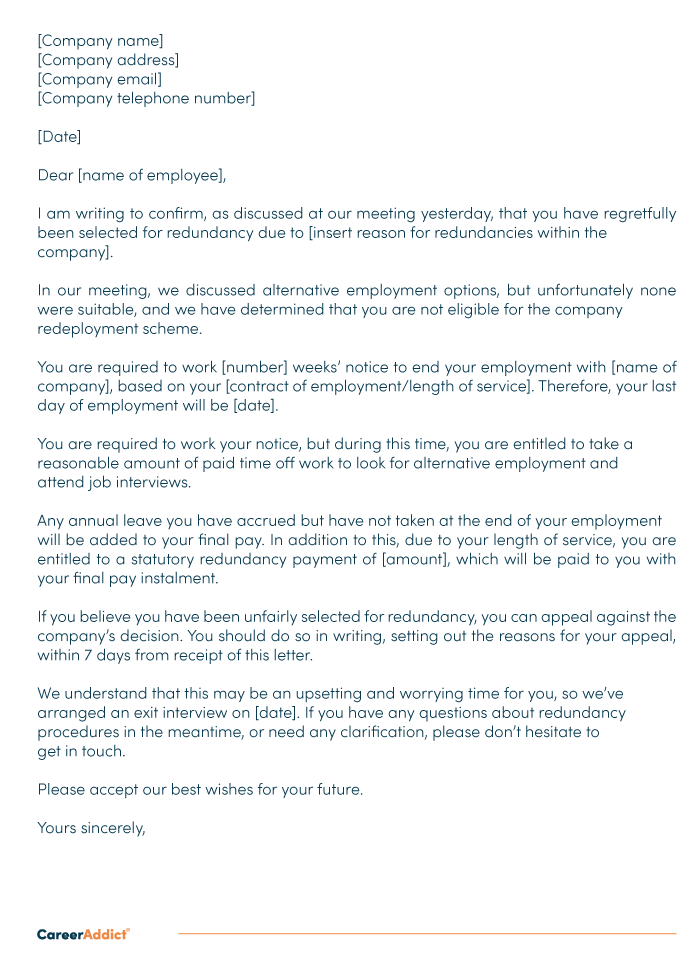Just How to Take Care Of Redundancy Pay If Company Goes Bust: Trick Details for UK Employees
Just How to Take Care Of Redundancy Pay If Company Goes Bust: Trick Details for UK Employees
Blog Article
Investigating the Interplay In Between Business Redundancy and Business Versatility for Future Development
In the dynamic landscape of today's service world, the complex partnership in between company redundancy and organizational adaptability emerges as a vital variable for continual development and success. Firms often face the challenge of striking a delicate balance between maintaining a level of redundancy to alleviate risks and cultivating flexibility to react promptly to the ever-evolving market needs.
Importance of Firm Redundancy
Firm redundancy is a crucial element that boosts business strength and alleviates functional dangers. By integrating redundancy steps within the organizational framework, firms can much better hold up against unpredicted disturbances and variations in business atmosphere. Redundancy functions as a tactical buffer, permitting firms to adapt and respond effectively to unexpected obstacles without jeopardizing vital operations.
One trick element of the significance of company redundancy is its duty in making certain connection during times of situation. When encountered with sudden adjustments or emergency situations, redundant systems, sources, or workers can step in to keep vital functions and prevent prevalent interruptions. This connection not only safeguards the company's track record and customer trust fund yet additionally minimizes financial losses and functional downtime.

Approaches for Business Flexibility

One more critical strategy is purchasing innovation and facilities that can sustain versatility and scalability. Applying electronic devices, automation, and information analytics can simplify procedures, boost effectiveness, and supply beneficial understandings for educated decision-making. In addition, developing versatile business frameworks that enable for fast modifications to market characteristics and client demands is important for staying competitive in a rapidly evolving environment. By proactively recognizing possible disturbances and chances, organizations can proactively adapt and thrive in an ever-changing company landscape.
Balancing Redundancy and Flexibility
Achieving a harmonious balance in between operational redundancy and organizational adaptability is critical in browsing the complexities of a vibrant company setting. Striking the ideal balance between redundancy and versatility is a fragile procedure that requires a deep understanding of the organization's objectives, industry dynamics, and danger resistance.
To attain this equilibrium, firms require to perform normal analyses of their operations to determine areas where redundancy is required for danger mitigation and where adaptability can drive development and growth. Implementing flexible frameworks, cultivating a society of constant knowing and enhancement, and encouraging open communication across all levels of the company are crucial methods to harmonize redundancy and flexibility properly. By lining up these two crucial elements, firms can place themselves for sustainable development and success in an ever-changing business landscape.
Case Researches on Adjustment Success
In analyzing instances of effective organizational adaptation, it becomes noticeable that the interplay in between functional redundancy and adaptability is a specifying consider forming durable businesses. One engaging case research is that of Netflix. At first a DVD rental service, Netflix showed amazing flexibility by transitioning into a streaming system when digitalization interrupted the sector. By tactically purchasing innovation and web content creation, Netflix not just made it through yet prospered in a quickly evolving market. One more standout instance is Amazon. Starting as an on-line bookstore, Amazon constantly adapted its organization model, increasing into diverse fields such as cloud computing and expert system. This flexibility enabled Amazon to remain ahead of competitors and satisfy transforming consumer needs. Lastly, Adobe supplies a significant illustration of successful adjustment. The firm shifted from offering software program licenses to a subscription-based model, guaranteeing persisting earnings streams and enhanced client interaction. These situation researches underscore the significance of operational redundancy combined with business flexibility in cultivating long-term growth and competitiveness.
Structure Durability for Future Growth
Building resilience for future development calls for a strategic alignment of functional procedures with market dynamics and arising fads. Companies need to adapt to transforming atmospheres by promoting a culture of flexibility, technology, and continuous improvement. Strength involves not just recuperating from troubles yet likewise proactively planning for future difficulties. One essential aspect of structure strength is purchasing robust threat management methods to mitigate prospective disturbances. This consists of scenario preparation, diversifying supply chains, and developing backup prepare for numerous contingencies (who pays redundancy money).
Furthermore, cultivating strong connections with stakeholders, such as customers, workers, distributors, and the community, is crucial for weathering unpredictabilities and preserving count on and assistance during rough times. Reliable communication and transparency play a crucial duty in building durability, as they assist straighten expectations and help with collaboration in navigating uncertainties.
Moreover, companies need to prioritize knowing and advancement campaigns to upskill staff members and equip them with the required tools to adapt to altering circumstances. By buying their workforce, business can improve their flexibility and dexterity, inevitably reinforcing their strength for lasting future development.
Conclusion

In the dynamic landscape of today's company world, the detailed connection between firm redundancy and organizational adaptability emerges as a critical element for continual development and success. Business usually encounter the obstacle of striking a fragile balance in between maintaining a level of redundancy to minimize threats and cultivating versatility to respond quickly to the ever-evolving market needs.To achieve this equilibrium, companies need to conduct regular analyses of their operations to determine areas where redundancy is necessary for risk reduction and where flexibility can drive development and growth.In conclusion, the interaction in between company redundancy and business flexibility is vital for future growth. Structure durability with a combination of redundancy and flexibility will make certain that companies are prepared for the difficulties of the future.
Report this page